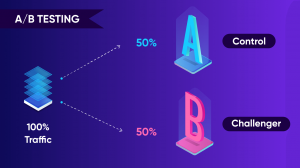From Guesswork to Data: The Benefits of SEO A/B Testing
WHAT IS A/B TESTING IN SEO?
SEO A/B testing, also known as split testing, involves comparing two versions of a webpage or SEO element to determine which one performs better in terms of specific metrics like organic traffic, click-through rate (CTR), and conversion rate. This method allows you to isolate variables and make informed decisions based on actual user behaviour. It is actually an optimization of web pages before and after testing.
Why Conduct SEO A/B Testing?
SEO A/B testing is essential for several reasons which are given below:
- Data-Driven Decisions: It eliminates guesswork and assumptions and helps you make decisions based on empirical data.
- Improved Performance: By identifying what works best, you can continually optimize your website for better performance and check your website time to time for better performance. Various techniques or tools through which we analyze your website which ultimately help in website performance
- User Experience: Testing different elements can enhance user experience, leading to higher engagement and conversion rates. Through which you know about the user’s actual response in which field then you easily experience the users.
- Competitive Advantage: Staying ahead of competitors by implementing the most effective SEO strategies. Through the various strategies you will know about the competitors and you will look towards you negative things.
Various Steps to Conduct SEO A/B Testing
1. Define Your Objective : Before starting, clearly define what you want to achieve with your A/B testing. Your Common objectives include increasing organic traffic, improving CTR, or boosting conversions and enhancement of users . Having a clear goal will guide your testing process and help measure success.
2. Select the Variable to Test
Choose the specific element you want to test. This could be:
-
- Title tags
- Meta descriptions
- Header tags (H1, H2, etc.)
- Content length and structure
- Internal linking
- Image alt texts
- Call-to-action (CTA) placements
3. Create Variations : Develop two versions of the webpage or element. The original version is the control, and the modified version is the variant. Ensure that you change only one element at a time to accurately measure its impact.
4. Implement the Test : Use A/B testing tools or manual methods to implement the test. Some popular A/B testing tools include Google Optimise, and VWO. Split your audience randomly between the control and variant versions to ensure unbiased results.
5. Monitor and Analyse Results : Run the test for a sufficient period to gather meaningful data. Monitor key metrics such as organic traffic, CTR, bounce rate, and conversion rate. Use statistical analysis to determine whether the changes in metrics are significant.
6. Draw Conclusions and Implement Changes : Based on the results, determine which version performed better. If the variant outperforms the control, implement the changes across your site. If the results are inconclusive, consider running another test or trying a different variable.
Examples of SEO A/B Testing
- Title Tag Optimization
Test different versions of title tags to see which one attracts more clicks.
For example : compare a title tag that emphasises benefits (“Best Running Shoes for Comfort and Performance”) with one that uses urgency (“Buy Now: Top Running Shoes on Sale”).
2. Content Structure : Experiment with different content structures. Test a long-form article against a shorter, more concise version to see which one ranks higher and engages users better. It means you will know whether the long form article is good compared to the short term article.
3. Internal Linking : Test different internal linking strategies. Compare a page with a higher number of internal links against one with fewer links to determine the impact on user navigation and SEO performance.
/blog/seo-myths-busted-what-really-works-and-what-doesnt/
/blog/seo-boost-how-engaging-content-transforms-search-engine-rankings/
Best Practices for SEO A/B Testing
- Test One Element at a Time: if you want accuracy you have to measure the impact of changes, only test one element at a time then you will find best or good results.
- Use a Large Sample Size: Ensure you have enough data to draw meaningful conclusions. A larger sample size increases the reliability of your results.
- Run Tests for a Sufficient Duration: Allow tests to run long enough to account for variations in traffic and user behaviour.
- Document Your Tests: To Keep detailed records of your tests, including hypotheses, test duration, results, and conclusions. Make a hypothesis of the documents.
Conclusion
SEO A/B testing is a powerful tool for optimizing your website’s performance and enhancing your SEO strategy. By conducting controlled experiments, you can make data-driven decisions that lead to better organic traffic, higher engagement, and increased conversions. Remember, SEO is an ongoing process, and continuous testing and optimization are key to staying ahead in the competitive digital landscape. Embrace SEO A/B testing to experiment, learn, and achieve optimal results.
/blog/unlock-higher-rankings-understanding-the-importance-of-seo/


